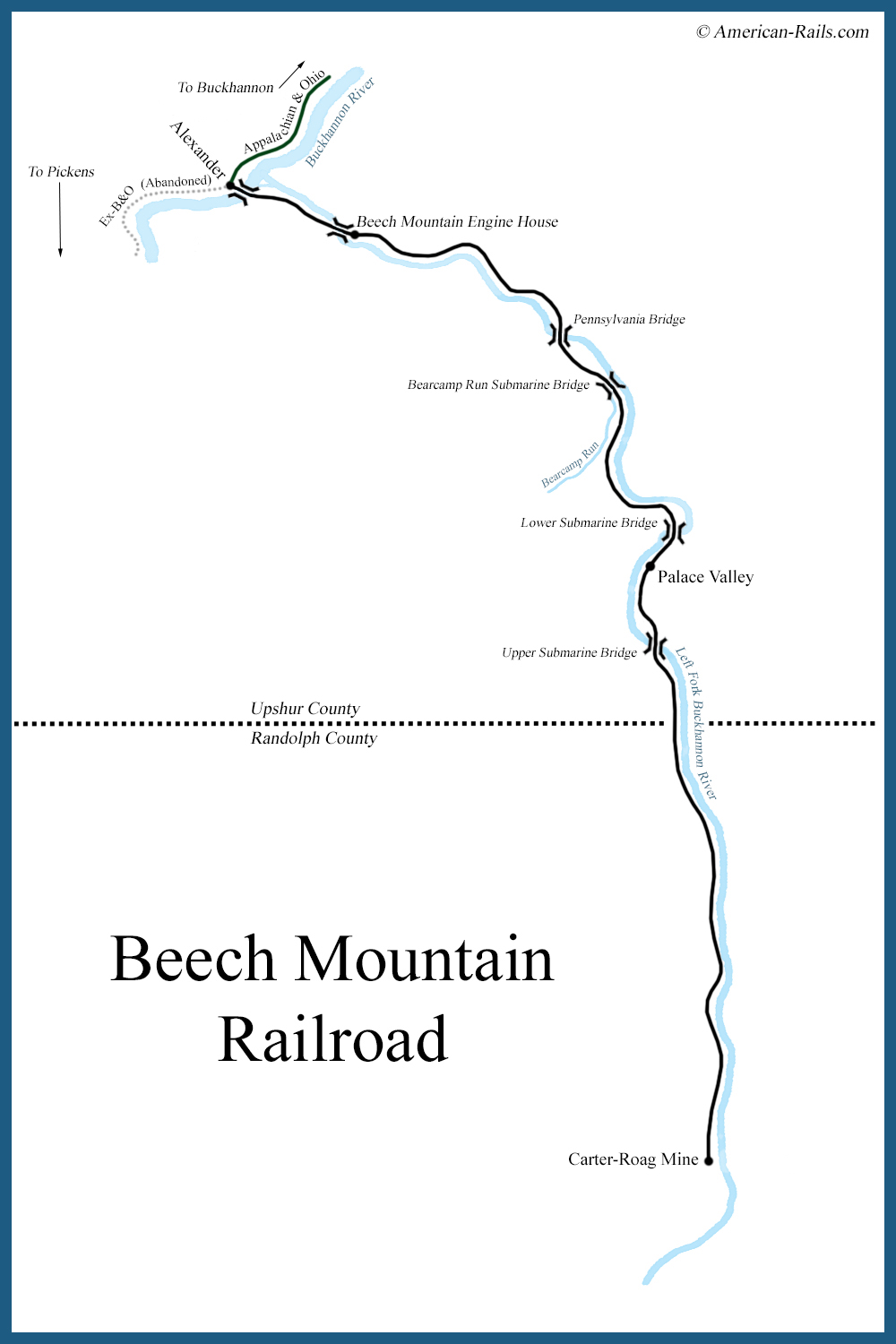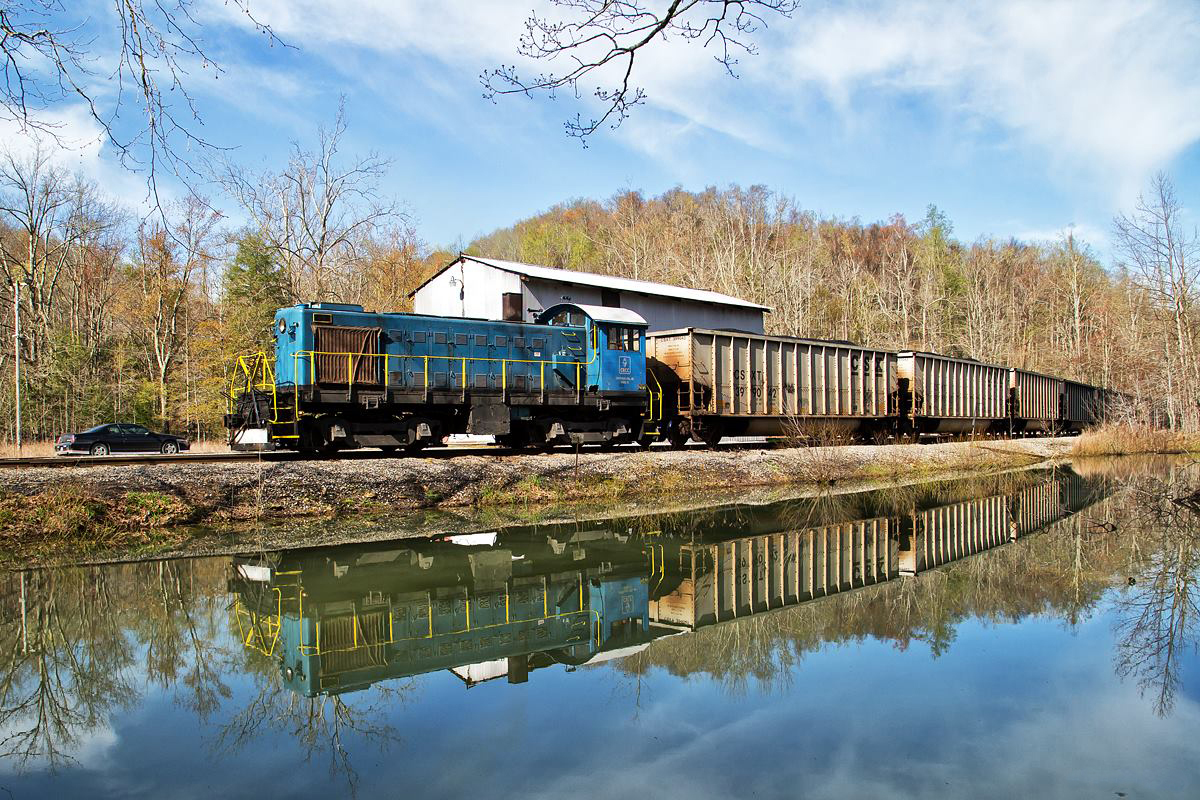Beech Mountain Railroad: A WV Coal-Hauler (1890-2023)
Last revised: August 30, 2024
By: Adam Burns
When the logging industry took root in the Mountain State during the late 19th century many companies constructed railroads or tramways to handle logs for processing, which led to the creation of what would eventually become the Beech Mountain Railroad.
While the little line was originally designed to handle forest products it later transitioned into a coal-hauler, a source of freight that sustained it until 2023. Over the years the operation was mothballed, and then revived, with the fluctuations brought about by the coal industry.
More than once it appeared the railroad's fate was sealed. Today, the railroad remains active despite a statute that it was slated to close in late December of 2015 following the cessation of operations at the only coal mine it served. However, a Trains Newswire report released on May 22, 2023 has stated Carter-Roag Coal Company's Morgan Camp mine, the last coal mine in Randolph County, and accompanying Star Bridge coal preparation plant, were slated to close.
For train enthusiasts this is one of the most remote and out-of-way short lines you can railfan. The ability to catch the railroad in action is extremely difficult due to its erratic and unpredictable schedule.
It typically requires insider information. Otherwise, one can wait for days without ever seeing a train. A big thanks to Loyd Lowry, in addition to Wade Massie, for the photos of this unique little operation.
Photos
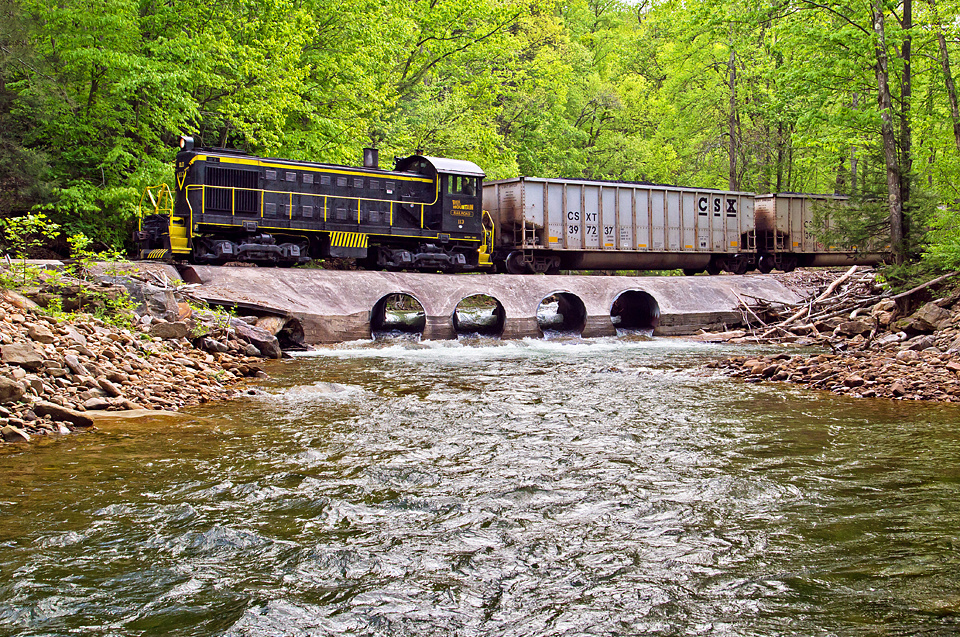 Photographer Loyd Lowry was able to catch the fleeting Beech Mountain in service on May 18, 2014 as S2 #113 pulls loads across the Upper Submarine Bridge at Palace Valley, West Virginia and towards the A&O interchange at Alexander.
Photographer Loyd Lowry was able to catch the fleeting Beech Mountain in service on May 18, 2014 as S2 #113 pulls loads across the Upper Submarine Bridge at Palace Valley, West Virginia and towards the A&O interchange at Alexander.History
Somehow, someway the small Beech Mountain Railroad (reporting mark, BEEM) continued to persevere for decades, despite several stoppages of service or dormant periods over the years.
The operation began in 1890 when the Alexander Lumber Company constructed a narrow-gauge tramway along the Left Fork of the Buckhannon River in present-day Upshur County, West Virginia.
At A Glance
3 Feet (1890 - 1892) 4 Feet, 8 ½ Inches (1892 - 1940, 1953 -) | |
Unfortunately, the operation wasn't particularly successful at its intended task of moving logs. As a result it was replaced with a standard-gauge system in 1892 known as the Alexander & Rich Mountain Railroad.
The A&RM worked its way southeasterly along the river and connected with the Baltimore & Ohio's Pickens Branch at Alexander. In a move that was quite common within the logging industry the operation changed hands several times.
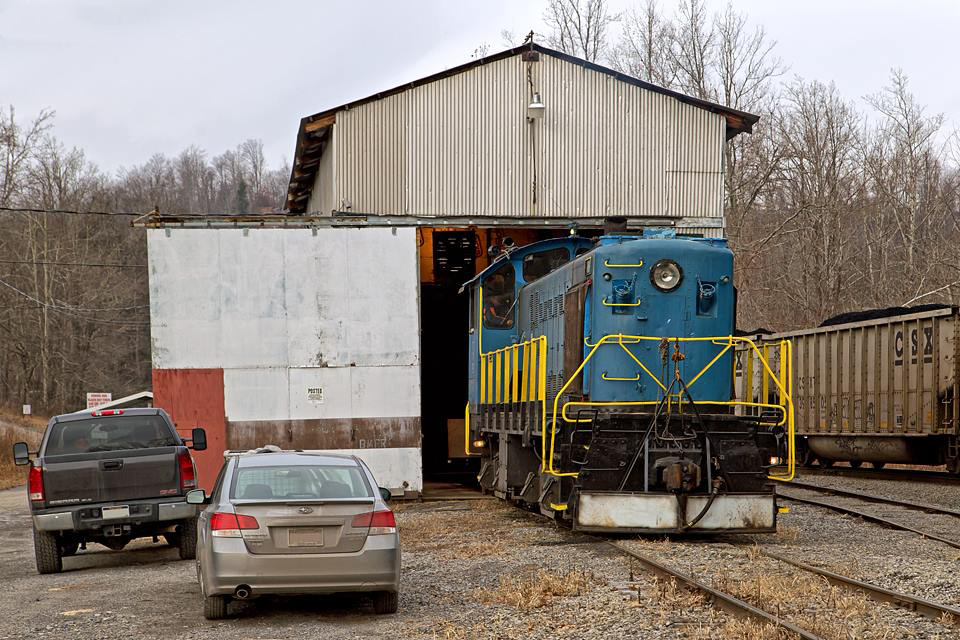 Beech Mountain Railroad S4 #115 is put away at the engine house in Alexander after moving its last load of 25 cars from Star Bridge to the interchange on December 21, 2014. Loyd Lowry photo.
Beech Mountain Railroad S4 #115 is put away at the engine house in Alexander after moving its last load of 25 cars from Star Bridge to the interchange on December 21, 2014. Loyd Lowry photo.In 1900 the A&RM was sold to the Randolph Coal & Lumber Company, which re-chartered the system as the Alexander & Rich Mountain Railway.
During December of 1906 another name change occurred as the Alexander & Eastern Railroad. While some coal was transported during this time timber still remained the dominant freight.
The infrastructure was built to typical logging standards with hastily constructed rights-of-way utilizing shoddy bridges.
In some cases, there were no bridges at all as steam locomotives simply forded the river, an operation which loggers later realized was not possible with diesels (a few inches of water will short-out the locomotives' electric traction motors).
The size of the A&E ebbed and flowed as rails were laid to reach new stands of timber and then pulled up as tracts played out.
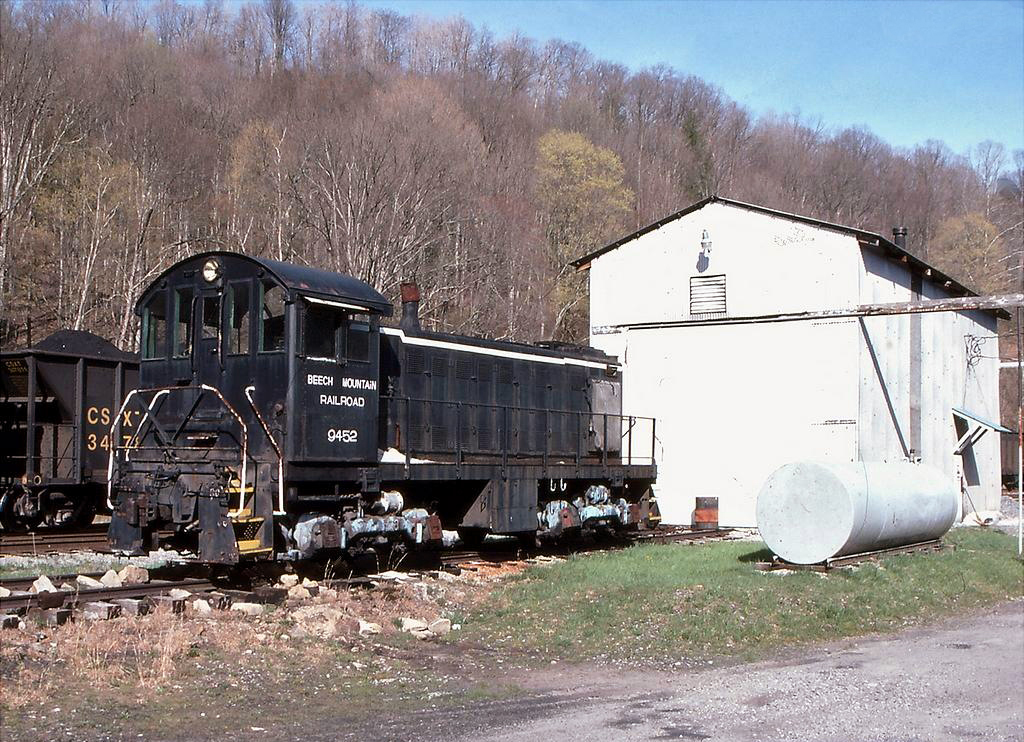 Prior to the 199-2004 shutdown, Beech Mountain Railroad S1 #9452 is seen here at the company's small engine-house in Alexander on April 23, 1994. Wade Massie photo.
Prior to the 199-2004 shutdown, Beech Mountain Railroad S1 #9452 is seen here at the company's small engine-house in Alexander on April 23, 1994. Wade Massie photo.According to Alan Byer's article, "Submarine Railroad In West Virginia," from the September, 2012 issue of Trains Magazine the movement of logs persisted until owner F.C. Cook & Company elected to discontinue rail operations in 1940 and use the right-of-way as a standard roadway for trucks.
Unfortunately, the idea proved less than satisfactory as the flood-prone Left Fork made the entire operation a muddy, impassable mess.
During World War II the final sawmill was closed at Alexander and the former right-of-way later purchased by E.L. Claghorn in 1953.
He was a developer from Pennsylvania and looked to use the corridor for an entirely different purpose, the movement of coal taken from seams located near the small town of Helvetia.
System Map
Locomotive Roster
The newly incorporated Beech Mountain Railroad was formed and rails re-laid (to much heavier standards than before) from the B&O interchange at Alexander to a point south of Star Bridge known as Beech Run Junction in Randolph County, a distance of 10 miles.
A small, center-cab diesel switcher from the Whitcomb Locomotive Works was initially used; a model model 80-DE-6A built in 1942 as U.S. Navy #65-00082 it was sold to the Beech Mountain and given #100.
The railroad would go on to own several switchers. They include:
- Whitcomb model 65-DE-19A (another center-cab) built in April of 1944 for the U.S. Army as #8442 it saw three different owners over the years before being acquired by the Beech Mountain and given #42.
- Alco S2 #113 was built as Michigan Limestone & Chemical in 1946 as #113, its nickname is "Old 113." (Active)
- EMD SW7 #114 is a recent addition to the fleet, a former New York Central unit that formerly operated at a United Coal Kentucky subsidiary. (Active)
- Alco S1 #9452 was formerly Penn Central #9452 and built as Pennsylvania #9102 in 1949.
- Alco S4 #115 was built as Michigan Limestone & Chemical #115 in 1950, its nickname is "Bear's Blue Ox." (Active)
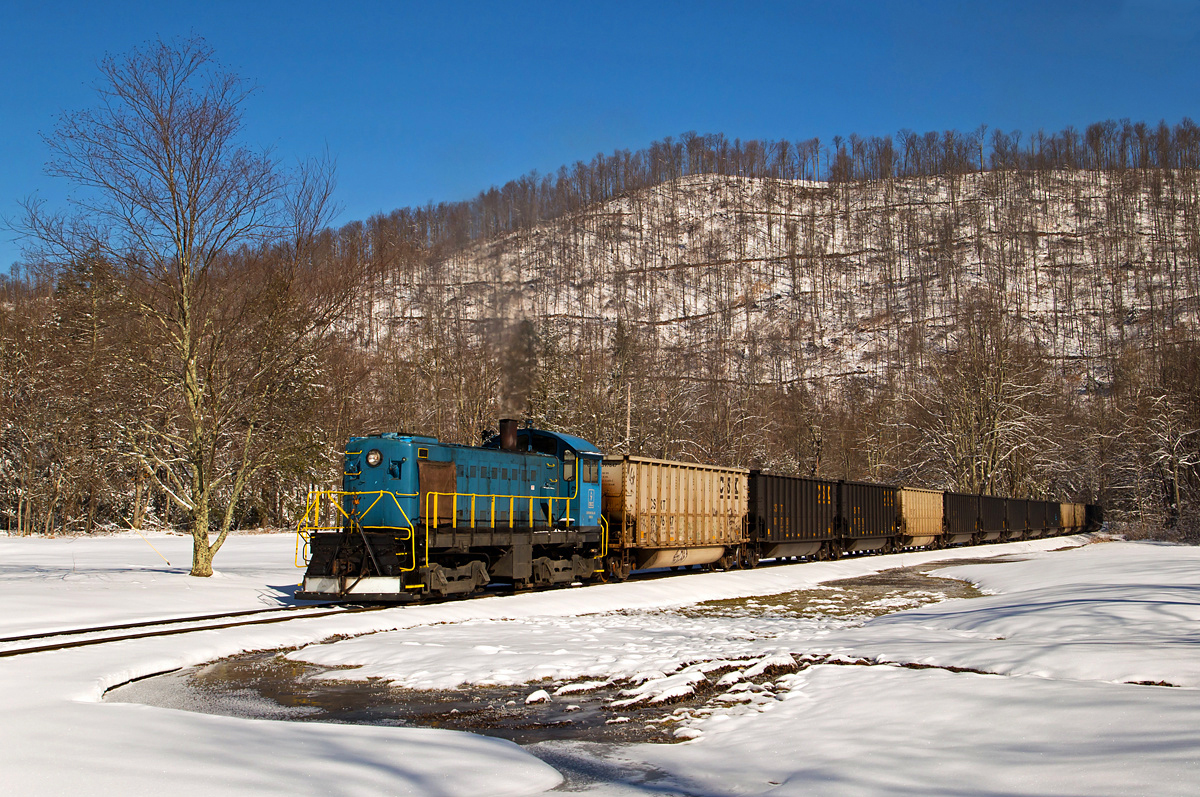 Beech Mountain #115 is nearly dwarfed by its cut of hoppers as the little switcher heads back to the mine with empties near Palace Valley on March 7, 2015. Loyd Lowry photo.
Beech Mountain #115 is nearly dwarfed by its cut of hoppers as the little switcher heads back to the mine with empties near Palace Valley on March 7, 2015. Loyd Lowry photo.Over the years the Beech Mountain saw service disruptions as mines closed and the railroad wasn't needed. It saw a 7-year hiatus from 1998 until 2005 when service was reopened by Carter-Roag on February 14, 2005. Following this short stint, the railroad was again mothballed for a time until being reopened in April, 2009.
However, only the 8 miles to Star Bridge remained in service as the final 2 miles to Beech Run Junction was abandoned. According to Mr. Byers' article the railroad usually operates six to eight times per month using S2 "Old 113" on the main line while S4 "Bear's Blue Ox" shuttles hoppers at the load-out site. Recently, however, the locomotives have switched roles due to mechanical issues with #113.
Official Guide Listing
The railroad's most interesting feature are the series of so-called "submarine bridges" it has custom-built, and subsequently modified over the years, to deal with the turbulent nature of the Left Fork.
The bridges received their name via the way they are designed, allowing flood waters to rush over top without destroying the track or other infrastructure.
Essentially, it works by encasing several culverts within an elevated embankment of concrete. The track is either placed within the concrete or situated on top.
The railroad first experimented with the idea dating back to the 1940s and has perfected it several times since. Usually, the bridges work quite well but on occasion the river still defeats the best laid plans and undermines the right-of-way.
 Beech Mountain #115 pulls a cut of loads towards the interchange with the Appalachian & Ohio at Alexander on March 7, 2015. Loyd Lowry photo.
Beech Mountain #115 pulls a cut of loads towards the interchange with the Appalachian & Ohio at Alexander on March 7, 2015. Loyd Lowry photo.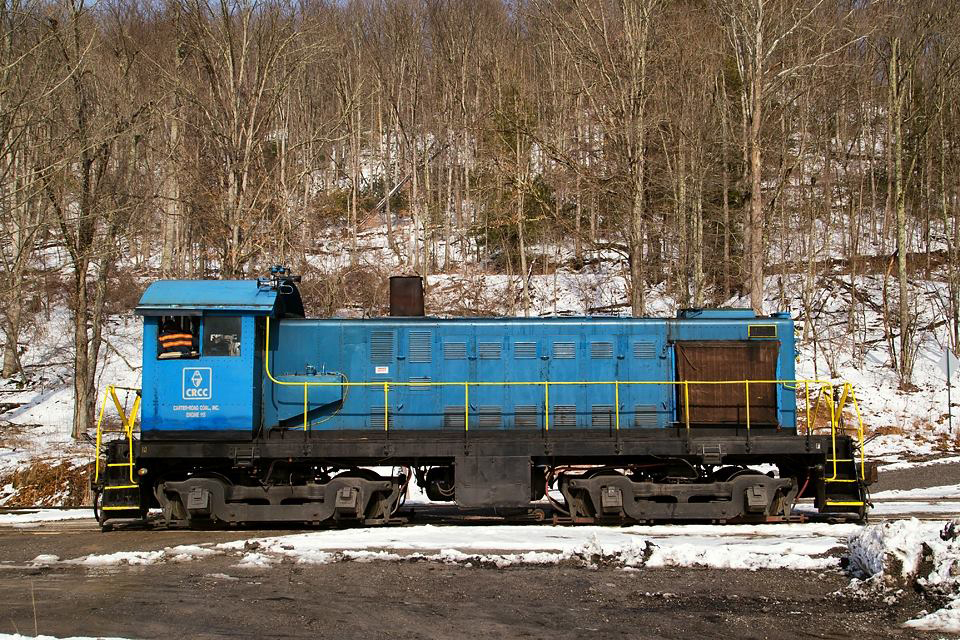 Beech Mountain #115 sits next to the road's small, single-engine shop complex located near the hamlet of Alexander on March 7, 2015. Loyd Lowry photo.
Beech Mountain #115 sits next to the road's small, single-engine shop complex located near the hamlet of Alexander on March 7, 2015. Loyd Lowry photo.Today, the interchange at Alexander is operated by short line Appalachian & Ohio, which handles loads and empties back to Grafton where they are picked up by CSX.
The future of the Beech Mountain was again in doubt when the Carter-Roag announced in October of 2015 it would close its mine at Mill Creek on December 25th that year.
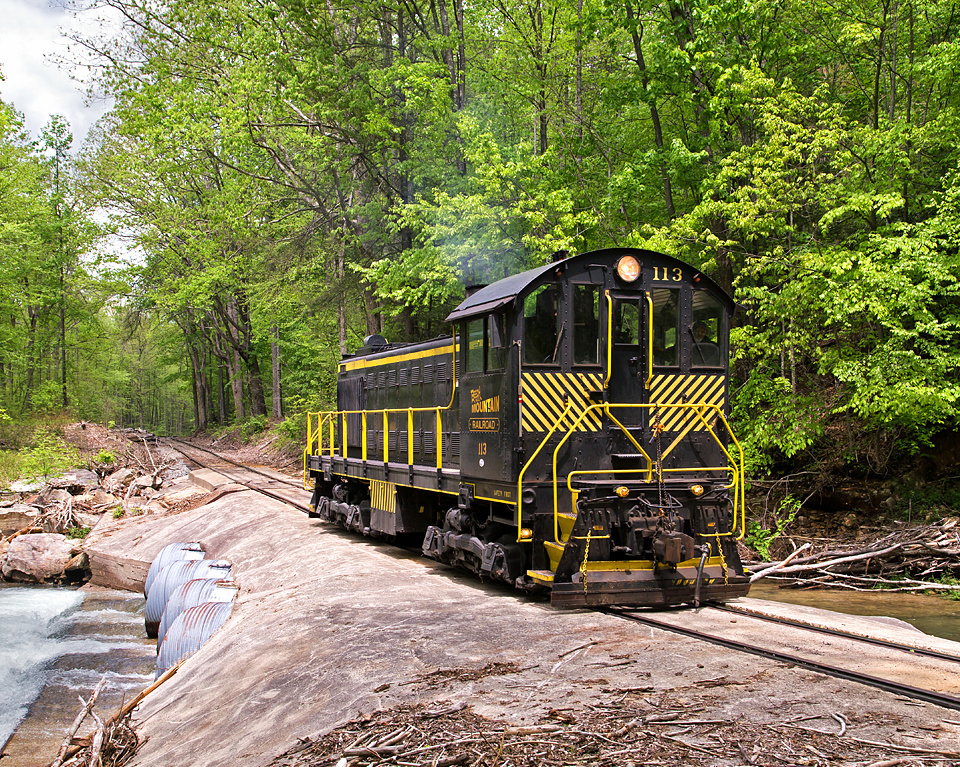 Another view of "Old 113" running light across the Upper Submarine Bridge as it heads back to the mine at Star Bridge for more loads. Loyd Lowry photo.
Another view of "Old 113" running light across the Upper Submarine Bridge as it heads back to the mine at Star Bridge for more loads. Loyd Lowry photo.2023 Closure
The closure, at the time, would have resulted in the loss of 170 jobs and also affect the Appalachian & Ohio, which depended on coal shipments for the majority of its traffic.
Despite this statement, operations continued for nearly another eight years but local news reports in May, 2023 that Carter-Roag's Morgan Camp mine, the final coal mine still in operation in Randolph County, was playing out and slated for closure.
The closure will result in over 200 job losses and, presumably, the end of the Beech Mountain Railroad whose only purpose is to handle loads of coal from the mine to the Appalachian & Ohio interurban. The disposition of the railroad's current roster of three switchers remains unknown.
Recent Articles
-
Wisconsin Dinner Train Rides In North Freedom!
Jan 06, 26 10:18 PM
Featured here is a practical guide to Mid-Continent’s dining train concept—what the experience is like, the kinds of menus the museum has offered, and what to expect when you book. -
Pennsylvania Dinner Train Rides In Boyertown!
Jan 06, 26 06:48 PM
With beautifully restored vintage equipment, carefully curated menus, and theatrical storytelling woven into each trip, the Colebrookdale Railroad offers far more than a simple meal on rails. -
North Carolina ~ Murder Mystery ~ Dinner Train Ride
Jan 06, 26 11:26 AM
While there are currently no murder mystery dinner trains in the Tarheel State the Burgaw Depot does host a murder mystery dinner experience in September! -
Florida's - Murder Mystery - Dinner Train Rides
Jan 06, 26 11:23 AM
Florida, known for its vibrant culture, dazzling beaches, and thrilling theme parks, also offers a unique blend of mystery and fine dining aboard its murder mystery dinner trains. -
New Mexico's - Wine Tasting - Train Rides
Jan 06, 26 11:19 AM
For oenophiles and adventure seekers alike, wine tasting train rides in New Mexico provide a unique opportunity to explore the region's vineyards in comfort and style. -
Ohio's - Wine Tasting - Train Rides
Jan 06, 26 11:14 AM
Among the intriguing ways to experience Ohio's splendor is aboard the wine tasting trains that journey through some of Ohio's most picturesque vineyards and wineries. -
Connecticut's Thomas The Train Rides
Jan 06, 26 11:06 AM
For 2026, the tour stop at Essex brings Thomas (and Percy, too) to the historic Valley Railroad for a full day of events for the kids. -
Maryland's Thomas The Train Rides
Jan 06, 26 11:00 AM
In 2026, the B&O Railroad Museum in Baltimore welcomes the Let’s Rock, Let’s Roll Tour with four event days that combine a Thomas-themed excursion with other activities. -
Tennessee's Thomas The Train Rides
Jan 06, 26 10:51 AM
Set on the grounds of one of the Southeast’s best-known operating railroad museums, the Thomas the train event blends kid-friendly fun with the unmistakable sights, sounds, and atmosphere of a real wo… -
Georgia's Thomas The Train Rides
Jan 06, 26 10:44 AM
Day Out With Thomas is set to roll back into Cordele in 2026, bringing Thomas the Tank Engine and a full family festival to the SAM Shortline at Georgia Veterans Memorial State Park. -
Staten Island Rapid Transit
Jan 06, 26 10:02 AM
The Staten Island Rapid Transit has long served Staten Island since the 19th century and today is known as the Staten Island Railway. -
New York Dinner Train Rides In The Adirondacks!
Jan 05, 26 09:45 PM
Operating over a restored segment of the former New York Central’s Adirondack Division, the Adirondack Railroad has steadily rebuilt both track and public interest in passenger rail across the region. -
Ohio Dinner Train Rides On The CVSR!
Jan 05, 26 08:32 PM
While the railroad is well known for daytime sightseeing and seasonal events, one of its most memorable offerings is its evening dining program—an experience that blends vintage passenger-car ambience… -
Pennsylvania's - Wine Tasting - Train Rides
Jan 05, 26 01:08 PM
Wine tasting trains are a unique and enchanting way to explore the state’s burgeoning wine scene while enjoying a leisurely ride through picturesque landscapes. -
West Virginia - Wine Tasting - Train Rides
Jan 05, 26 01:02 PM
West Virginia, often celebrated for its breathtaking landscapes and rich history, offers visitors a unique way to explore its rolling hills and picturesque vineyards: wine tasting trains. -
Virginia - Wine Tasting - Train Rides
Jan 05, 26 12:58 PM
Wine tasting trains in Virginia provide just that—a unique experience that marries the romance of rail travel with the sensory delights of wine exploration. -
Utah - Wine Tasting - Train Rides
Jan 05, 26 12:37 PM
Utah, a state widely celebrated for its breathtaking natural beauty and dramatic landscapes, is also gaining recognition for an unexpected yet delightful experience: wine tasting trains. -
Kentucky Valentine's Train Rides
Jan 05, 26 12:31 PM
If you’re looking for a date night that feels a little more cinematic than the usual reservation-and-a-movie routine, Bardstown’s My Old Kentucky Dinner Train delivers the kind of evening you remember… -
Pennsylvania Valentine's Train Rides
Jan 05, 26 12:12 PM
Tucked amid the rolling farmland of Lancaster County, Pennsylvania, the Strasburg Rail Road stands as one of the most celebrated and successful heritage railroads in North America. -
New York's - Murder Mystery - Dinner Train Rides
Jan 05, 26 11:01 AM
New York State, renowned for its vibrant cities and verdant countryside, offers a plethora of activities for locals and tourists alike, including murder mystery train rides!

